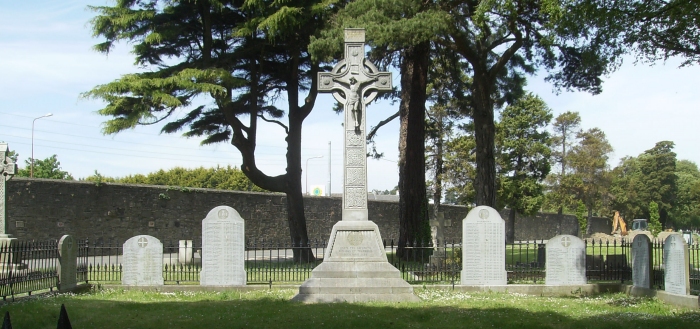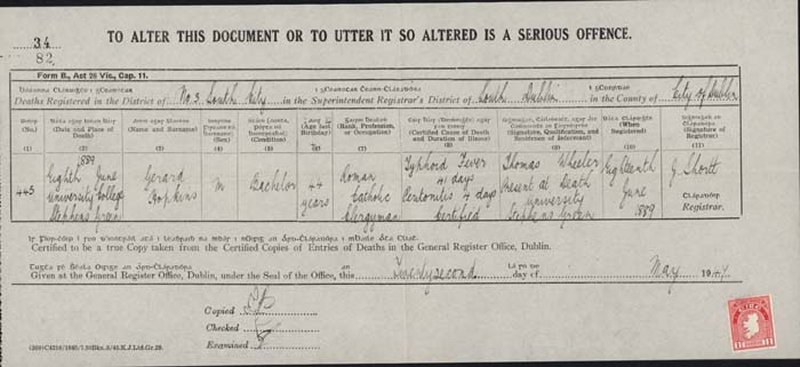Handwritten, autographed, Hopkins letters, with signature and dated from 1882—1888. Hopkins was 38 years old, a year before his death.. .
First published in Studies. An Irish Quarterly Review, 2 (1995)
Handwritten, autographed Hopkins Job Application
Joseph J. Feeney,S.J.St. Joseph's,
Philadelphia,
USA.
New, unknown Hopkins Letters discovered in July 1993, I discovered four unpublished, unknown manuscript letters of Gerard Manley Hopkins, all of biographical or literary importance . They are `autograph letters, signed' - handwritten, with signature - and date from 1882 (when Hopkins was 38 years old) to 1888 (a year before his death); three were written to fellow Jesuits (his only extant letters to Jesuits), the fourth to Cardinal Newman
. I found them at Gonzaga University, Spokane, Washington
, among the papers of the late Hopkins scholar, the Rev Anthony D. Bischoff, S.J.
, who had discovered them in England and Ireland, probably in 1947, and had kept them for a never completed biography.
The earliest letter was sent from Roehampton, London, on 17 August 1882, two days after Hopkins' Final Vows as a Jesuit. Responding to three Jesuit contemporaries in Preston who had written to congratulate him, Hopkins thanked them in a long, often playful letter. Addressing them as `my hearties' and `the three of yez', he told them about the Vow Ceremony, his reaction to it, and the assignment of Jesuit contemporaries. The Ceremony itself, he writes, was `striking and edifying' to many, but his own reactions were `mixed': he found it at once unimportant (it had merely juridical effects), saddening (he had hoped to be `professed' - a higher status ) but also consoling (his lower status made him feel humble with Christ). Making this frank admission `in confidence to the three of yez', he quickly turns to news about fellow Jesuits, mentions a common friend, and ends by wishing `best love' to several older Jesuits in Preston and by noting that he `must be in good spirits'. In language, the letter is inventive, even slangy: `my hearties', `the three of yez', `founding in tears', `gingerbread jokes', `Bilious Bouts', `got agate'. Unique, lively, and frank, this letter expresses Hopkins' most private thoughts as a Jesuit, written in trust and affection to three Jesuit friends.
Second Letter written in Dublin
The second letter is literary, responding to a query of the Rev. Matthew Russell, S.J., editor of The Irish Monthly. Written in Dublin on 10 October 1886 (Hopkins was teaching at University College), it evaluates a Latin rendering of the nursery rhyme `Sing a Song of Sixpence'. Beginning `My dear Father Mat', it lightly yet carefully examines the `game' of such translations: they require clarity, rhythm, `some notable happiness of rendering', fidelity to the nonsense of the original, and a fitting climax. In this case, the translation fails: despite some `good touches', it is `a poor thing' with `not enough to redeem it'. Yet Hopkins' letter is a delight, showing his wit, verbal sensitivity, care with texts, grasp of the Classics, and even his knowledge (by memory) of a Latin version of `Hey diddle diddle, the cat and the fiddle' (Hei didulum atque iterum didulum felisque fidesque).
Then, a Letter to John Henry Newman
The third letter went to John Henry Newman, Cardinal and founder of University College, then in retirement at the Oratory in Birmingham. Written at University College on 20 February 1888, it greeted Newman on his 88th birthday (21 February), then offered news of his College and of Ireland. `This poor University College', Hopkins writes, `is afloat and not sinking; rather making a very little way than losing any', despite public uninterest in the University question. `Politically', continues the English Hopkins, `the times are most troubled'; his sole hope is that Pope Leo XIII will condemn the Plan of Campaign. But a few consolations remain: `the Senate of the Royal University is very friendly to us and to Catholic interests', and his Irish friend George Teeling, lodged nearby on Stephen's Green, is recovering from an illness. Despite such consolations, though, the letter is February-dark in tone.
Fourth Letter Clarifies Origin of Sonnet
The fourth letter, again of literary importance, went from University College on 20 September 1888 to the Rev Francis Goldie, S.J., and clarifies the origin and style of Hopkins' sonnet `In honour of St. Alphonsus Rodriguez'. At the time, Goldie, an English Jesuit and once Hopkins' fellow novice, was writing a life of Alphonsus, a Jesuit laybrother newly canonized, and had requested a poem for the first feast of Saint Alphonsus Rodriguez on October 30. In his reply, Hopkins, though protesting a busy schedule, writes `Promise I cannot, but I will try something'. A stimulus, he adds, is an Irish friend's interest in Majorca and the Balearic Isles where Alphonsus spent his Jesuit life; Hopkins hopes to provide some local colour to offset the typically drab writing about saints. After a formal close (`Believe me yours affectionately in Christ') he adds a cryptic postscript: `You say nothing of the language: I suppose any that I possess'. Other letters make the meaning clear: after friends complained about the difficulty of `Tom's Garland' (1887) , Hopkins intends a simpler, more direct language to celebrate how `there went / Those years and years by of world without event / That in Majorca Alfonso watched the door' .
Notes
See Hopkins' comment in The Letters of Gerard Manley Hopkins to Robert Bridges, ed. C.C. Abbott, London: Oxford University Press, 1955, p. 272; Hopkins notes the new style of `In honour of St. Alphonsus Rodriguez' on p. 292.
The Poetical Works of Gerard Manley Hopkins, ed. Norman H. MacKenzie, Oxford: Clarendon


